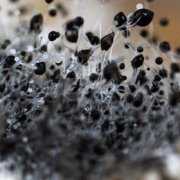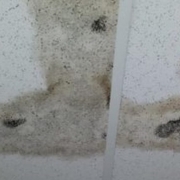$13 Million from Lumberyard Brings California Mold Settlement to $22.6 Million
Los Angeles, CA – Last week, a California family agreed to a $13 million settlement from a lumber company in mid-trial to complete a $22.6 million settlement with their homes contractors and suppliers over mold exposure. The family sustained severe health complications and it also caused one of their children to sustain severe brain injuries.
The Gorman family suffered respiratory and sinus problems shortly after moving into a new $1.9 million home in Manhattan Beach, in 1999. They stayed in the home for two years before moving because of deteriorating health problems, including brain lesions and cysts suffered by Kellen Gorman, now age 5, which were revealed in an MRI taken when the child was 3-1/2. An MRI taken when the child was 1-1/2 was normal. Other family members complained of numerous health problems, including cognitive difficulties, such as memory loss, which are often associated with fungal exposure.
Brain Damage
Kellen Gorman became sick because of mold on framing studs that had been improperly stored by Crenshaw Lumber Co. Inc. of Gardena, Calif. The company agreed to pay $13 million of the settlement. The studs were used in the custom-built Manhattan Beach, Calif., home the family lived in for about two years beginning in 1999. Only two types of indoor fungi have been linked to neurological problems; Chaetomium and Stachybotrys, while other mycotoxin-producing molds can lead to respiratory, digestive, and skin problems. While other fungi can lead to allergy problems.
In Kellen’s case, it was simple to prove that fungal exposure caused his severe brain damage. When the family first moved into the moldy house, an alert physician took a brain MRI immediately afterwards due to some initial mold exposure related problems he was experiencing. This included symptoms such as brain fog. The MRI showed little, however, after months of exposure, and Kellen’s problems became worse, another MRI was conducted on his brain. This MRI proved severe damage, including actual lesions and holes.
The Gormans finally moved out after two years. But by then, their son Kellen had suffered irreparable damage, including brain lesions and cysts. At age 5, he still functions as a 1 year old and needs round-the-clock care. His two sisters, now 7 and 3, did not suffer serious health problems. Witzer said an MRI conducted when Kellen was 3 years old revealed the lesions and, when compared to a problem-free MRI performed when he was 1, clearly showed the jury that the youngster’s brain had been damaged. The defense attempted to keep out medical testimony regarding the childs neurological injuries, but the judge ruled there was enough evidence to allow jurors to hear the opinions of doctors linking the damage to exposure to dangerous molds. Other powerful evidence came in the form of environmental testing and blood serum testing, which showed high levels of exposure to molds. Kellen’s father also complained of cognitive and neurological problems such as memory loss, which the plaintiffs medical experts testified is associated with exposure to certain fungi, Witzer said. Head in the sand Witzer said the owner of the lumber company testified at trial that he did not believe the mold on the lumber was dangerous and that the company did not have a policy to prevent mold from growing on its lumber. He indicated that, yes, there was black material on the wood prior to delivery, but that in his opinion this was just black stains or harmless molds, Witzer said. This is just inconsistent with all the scientific evidence that is out there now. He said Crenshaw did not follow industry recommendations to cover lumber and keep it dry to prevent mold. Basically [Crenshaw] ignored the instructions from the supplier to keep [the wood] dry, and they just left it out in the rain, Witzer said. They didn’t keep it raised twelve inches off the ground and they didn’t cover it. In fact, they kept the lumber in a puddle, just operating with their heads in the sand.
Costly Work
Although he believes mold litigation is poised to take off, Witzer warned that attorneys will have to put $250,000 or more into a case and be willing to risk failure. He said mold cases are typically very complicated, involving expensive medical testing that is usually not covered by health insurance, intensive environmental testing and costly experts whose travel expenses add up quickly, since many top mold authorities live out of the country. You have to treat it like a poisoning case, meticulously building up all the evidence and bringing in the top experts, Witzer said. This is a potentially wonderful area of litigation, but a toxic mold case cannot be handled like an automobile accident case. There was little for the mold naysayers and defense to do when the medical proof was this conclusive.
Kellen, now 5, functions as a 4-year-old and needs 24-hour care, says their attorney, Brian D. Witzer. Raymond P. Boucher, president of the Consumer Attorneys Association of Los Angeles, said the Oct. 19 settlement was the largest in the country for a mold case involving a single-family home.
Crenshaw settled the day after Los Angeles Superior Court Judge Victoria G. Chaney barred the wood supplier from using 10 of its 17 experts, including a toxicologist and a microbiologist, Witzer said. The judge excluded the experts because an attorney for the defense allegedly missed a deadline for designating witnesses and backdated a document to cover it up, Witzer said.
Brian D. Witzer said, we hope this settlement sends a signal to lumber yards nationwide to treat mold growth issues seriously and establish policies to protect the public?s health and safety. Currently, many lumber companies have been very negligent in their storage practices, often leaving lumber and wood products outside, exposed to the elements. Due to the fact that most lumber is untreated, this can often lead to mold growth.
Los Angeles County Superior Court Judge Victoria Chaney has scheduled a hearing for Nov. 14 to consider approval of the settlement terms for the three minor plaintiffs, Kellen M., Kyla M. and Tenley L. Gorman.
All but one defendant agreed in the weeks preceding trial to pay the Gormans a total of $9.6 million to settle individual claims, according to counsel. Plaintiffs presented evidence for six weeks and had nearly completed its case when the settlement was reached, counsel said.
Despite this victory, numerous mold cases on the plaintiffs behalf around the United States have lost, despite the credible evidence against the defendants. The same expert witnesses that the defense often hires are the same experts that were used for silicone implant and tobacco cases. When many of these experts could no longer make a viable living defending proven science they allegedly moved on to mold defense work. Slowly, the house of cards is falling and sound medical evidence is speaking for itself.
Written by Susan Lilliard-Roberts


 ©Photo Courtesy of drfungus.org
©Photo Courtesy of drfungus.org  ©Stern Mold
©Stern Mold 




